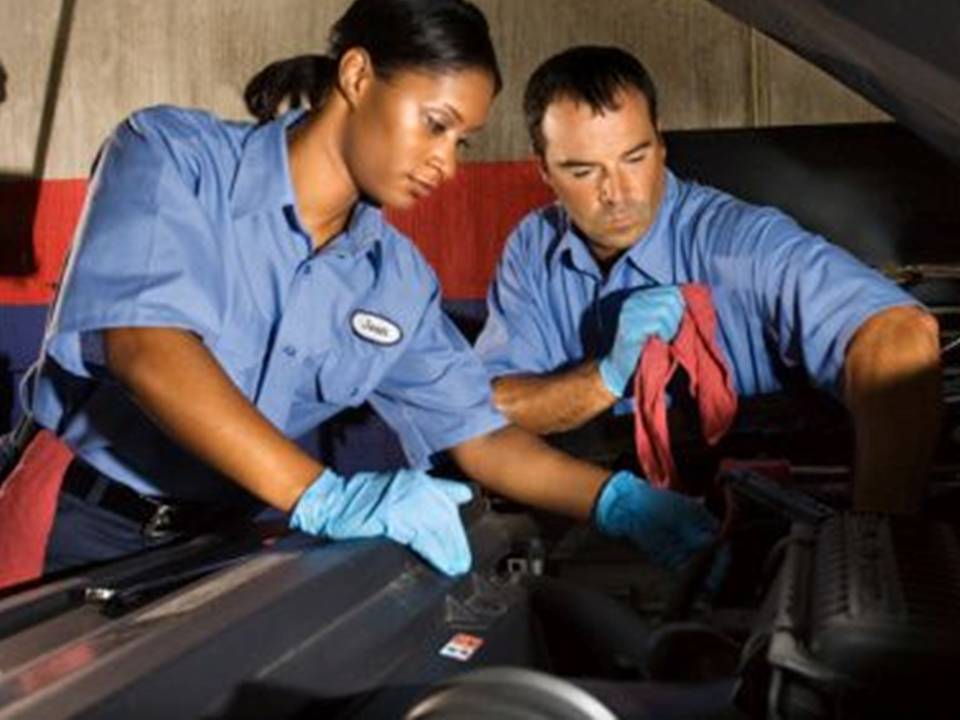Inspection Elements
On-Board Diagnostic (OBD) Inspection

Vehicles that are 1996 and newer will receive an OBD inspection. Today's vehicles have OBD computers that monitor the vehicle's engine and emission control system. When the computer detects a malfunction, a light on the dashboard is illuminated and a code identifying the malfunction is stored in the computer for access by a repair technician. By identifying specific malfunctions, OBD enhances the repair industry's ability to diagnose and repair vehicles.
What Vehicles require testing?
Vehicles kept in the following seven counties of southeastern Wisconsin are subject to emissions testing: Sheboygan, Washington, Ozaukee, Waukesha, Milwaukee, Racine and Kenosha.
Testing is required at Change of Ownership (>5 model years) and at time of Registration Renewal (every 2 years).
- 1996 - 2006 with a GVWR < 8,501 lbs. require testing (Gasoline Only)
- 2007 and newer with a GVWR < 14,001 lbs. require testing (Diesel and Gasoline)
Motorcycles are exempt from the emissions test
Testing Requirements for Registration Renewal Testing
Every other year, 1996 and newer vehicles (newest 3 model years are exempt) must be tested before their license plates can be renewed. Because this is a biennial test, the following model years will be tested to fulfill registration renewal testing requirements:
Model Years Subject to Testing for Registration Renewals Expiring in 2024:
1997, 1999, 2001, 2003, 2005, 2007, 2009, 2011, 2013, 2015, 2017, 2019, 2021
Model Years Subject to Testing for Registration Renewals Expiring in 2025:
1996, 1998, 2000, 2002, 2004, 2006, 2008, 2010, 2012, 2014, 2016, 2018, 2020, 2022
Testing Requirements for Change of Ownership Testing
Vehicles more than five model years old are subject to be testing upon change of ownership. Motorists receive notice of the emissions-testing requirement after they have titled and registered the vehicle. Failure to complete the emissions requirement within the allotted 45-day time period will result in the suspension of the newly purchased vehicle's registration.
Model Years Subject to Testing for Vehicles Purchased in 2024:
1996, 1997, 1998, 1999, 2000, 2001, 2002, 2003, 2004, 2005, 2006, 2007, 2008, 2009, 2010, 2011, 2012, 2013, 2014, 2015, 2016, 2017, 2018, 2019
Model Years Subject to Testing for Vehicles Purchased in 2025:
1996, 1997, 1998, 1999, 2000, 2001, 2002, 2003, 2004, 2005, 2006, 2007, 2008, 2009, 2010, 2011, 2012, 2013, 2014, 2015, 2016, 2017, 2018, 2019, 2020
Inspection Elements
- Check Engine Light Bulb Test
The inspector will perform a test to ensure that the vehicle's check engine light is functioning properly. This is accomplished by turning the ignition key to the on position without starting engine (KOEO) and looking for the check engine light while the vehicle is running (KOER). The vehicle would fail either portion of the inspection if the check engine light does not illuminate.
- Communications
The inspector will connect the testing equipment to the vehicle's onboard computer port (Diagnostic Link Connector). If the vehicle cannot communicate with the testing equipment, the vehicle will be rejected from further testing until this condition is corrected.
- Readiness Monitors
If the communication is established with the vehicle computer, then the OBD test can proceed unless unset readiness monitors exceed the testing requirements. For 1996 - 2000 model year vehicles, a vehicle can have up to 2 readiness monitors unset; for 2001 and newer vehicles, only 1 readiness monitor can be unset. If the unset readiness monitors exceed the requirements, the vehicle will be rejected from further testing until this condition is corrected.
- Check Engine Light Commanded On
If the vehicle's check engine light is commanded on due to an emission component that is not functioning properly, then the Diagnostic Trouble Codes (DTC) are recorded and provided to the motorist. The vehicle cannot pass the inspection if the check engine light is commanded on, but if no other information is available, getting a test before having repairs done can provide you with valuable information for your Repair Facility. The vehicle will need to be repaired and brought back for a reinspection.